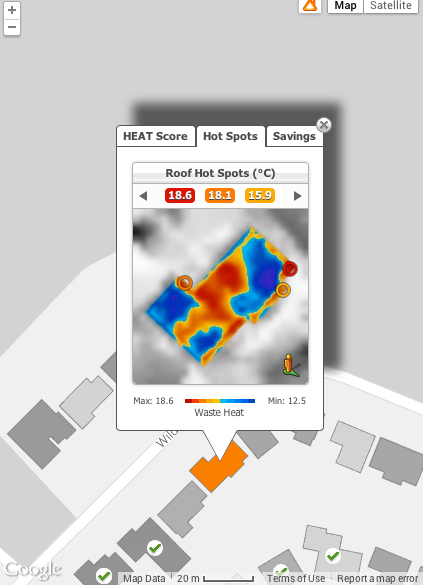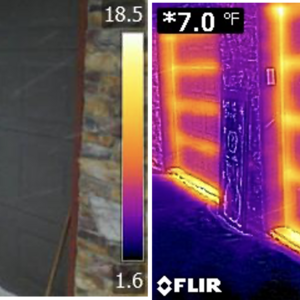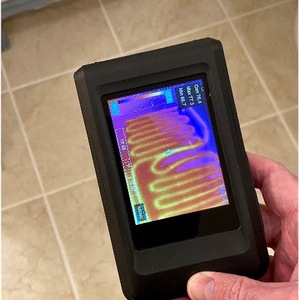
Image Credit: www.saveheat.co
A University of Calgary team has combined thermal imaging and Google maps to show thousands of city residents where their houses are leaking energy and how much money they could save by tightening them up.
The project, called Heat Energy Assessment Technologies or HEAT, gives residents of some neighborhoods in Calgary, Alberta, access to a free web site where they can pinpoint their home on a familiar Google map. Once the house is highlighted, they get a “HEAT score” showing how much energy is being wasted when compared with other houses in the city, a thermal image that shows hot spots, and projected savings in both dollars and greenhouse gases that would be possible by reducing average roof temperatures.
Researchers used a sophisticated thermal imaging camera mounted on an airplane to gather data and process the results for roughly 38,000 homes, a little more than 10% of the city’s total.
According to a news report on CBC News, the leader of the project is geography associate professor Geoffrey Hay, who started by testing his own house.
“I’m learning from the technology what’s actually wrong with my home,” he told the station. “I was able to put some insulation around my door, and significantly reduce the amount of energy coming out.”
Researchers overcome a variety of technical challenges
Gathering the raw data is more challenging than sticking a thermal imaging camera out the window of a plane and snapping a few frames.
Hay said by telephone the $650,000 high-resolution camera used to acquire the thermal data could detect differences in rooftop temperatures of as little as 5/100 of a degree Celsius. After the camera was calibrated, data was collected over the city of Calgary over a two-day period in May 2012 by an airplane that flew at 120 knots in a series of overlapping flight lines.
Hay and his fellow researchers had to develop several technologies to weed out potential problems and make the data useful. Wind, for example, can change temperatures and throw off results, so the team had to develop algorithms that would compensate for it. They needed software that would accurately stitch together overlapping images without chopping houses in half. The camera had to be mounted on a stable platform and linked accurately with GPS equipment in order to pinpoint houses on Google maps.
“The data set itself is about 660 gigabytes,” he said. “Processing that so you can see it on your web browser has been formidable. There have been a lot of challenges.”
What’s currently on the web site is phase two of the project. Phase one involved only 368 houses near the university, and making the leap to thousands of homes was an enormous undertaking, he said, involving 6,000 lines of computer code on the main web page alone.
Researchers have all the data they need to complete useful thermal images of the entire city, Hay said, but what they don’t have is the roughly $500,000 it would take to process the information and make it accessible on the web site. Funding to date has come from several sources, including the Institute for Sustainable Energy, Environment and Economy, and the Natural Sciences and Engineering Research Council of Canada.
Hay would like to see the city of Calgary or the Province of Alberta pick up the rest. Keeping free access to the site, he said, is key.
“It’s a free project,” he said. “We want to make the data sets available. We’re not commercializing anything, at the moment anyway — certainly not. It’s free for all the citizens. It would be great if the city were able to provide it.”
Helping people visualize what energy waste means
Hay got interested in the project because of shortcomings at his own house, which he described as a relatively new home in a neighborhood of houses costing between $450,000 and $650,000. In other words, not a low-rent district. The house has triple-pane windows, a high-efficiency heating system, and R-50+ insulation in the roof, but Hay came home one day and realized the house was cold.
“I thought, ‘Wouldn’t it be great if you could pull out your iPhone or your web device, click on Google maps, and up would come an image showing the energy leaving your home?’ ” he said. “And it would be color-coded from blue to red, and there would be hot spots showing you the hottest locations, and there would be some intelligence on it showing you whether it was linked to doors or windows.”
In addition to what’s already on the site, a tantalizing possibility is to add links to skilled builders or renovators, and possibly specific building products, that homeowners could use to fix the problems.
Energy savings and reductions in greenhouse gas emissions could be significant, Hay said, if enough people could be motivated to act.
“Everyone just needs to do a couple of little things,” he said. “But the biggest problem is very simple. The number-one reason for not being engaged in energy efficiency is simply, people don’t care. Why? Because they can’t see it. How can you be engaged in something you really can’t see? It’s invisible.
“So we show the invisible heat. We show it. We make it visible. We tell you how much energy is leaving. We show you where it’s located. And our objective next is to link you with the right individuals, the right companies, to show you what to do about it.”
There’s been a lot of interest in the project since the site went live in August, with more than 35,000 site visits from people in 86 different countries, Hay said.
Weekly Newsletter
Get building science and energy efficiency advice, plus special offers, in your inbox.















4 Comments
energy efficiency mapping for real estate industry
Brilliant! Imagine if a new home buyer could check out the heat loss score of a prospective house or whole neighbourhood before buying. That could also really help with targeted incentive programs for upgrading energy efficiency.
Privacy Concerns
Surely it isn't Mr Hay or anyone else's business how efficient an individual's home is? The Federal Privacy Commissioner has expressed concerns over the implications of using these types of technologies. I don't think the University of Calgary should be making the results publicly available. Unless a home is for sale it is not a commodity with attributes to be parsed by anyone with internet access.
RE:Privacy concerns
High resolution satellite photo - for both visible and infrared are available for purchase from the commercial imaging companies. Many of the imaging companies are outside of Canada and beyond the jurisdiction of the Federal Privacy Commission.
The imaging from the University of Calgary is not likely to be useful for much else than heat loss studies. If the the goal was to invade the privacy of the house - they could have done multiple frequent fly overs with ordinary visible cameras , combined that with Google maps.
The information they did gather is useful for many of the low income weatherization assistance programs. The utilities also could use the studies to help determine if added attic insulation would help with a house. Weatherization programs are often funded by the governments - and utilities spread their energy efficiency programs across to all the rate payers. Better selection of the houses that need work - means better use of public funds.
RE:Privacy concerns
Great , now LEO can easily check in and see all the grow ops out there and zero in on the exact address. No need to get off there collective asses and actually go and do a FLIR or a drone copter flyover to check.
Some peeps better start insulating and real soon.
CYA folks.
Log in or create an account to post a comment.
Sign up Log in